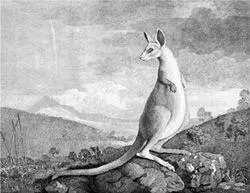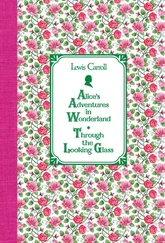7. Where the Sun Doesn’t Rise in the East
DRESSED FOR DINNER
The Guugu Yimithirr language has one famous claim to fame, and is consequently celebrated throughout the wide world of trivial pursuits. The story runs roughly like this. In July 1770, Captain Cook’s Endeavour was grounded off the northeastern coast of Australia, near the mouth of a river soon to be named Endeavour, in a place that was later to become Cooktown. During the weeks when the ship was being repaired, Captain Cook and his crew made contact with the native population of the continent, both human and marsupial. With the former, relations were at first rather cordial. Cook writes in his diary on July 10, 1770: “In the A.M. four of the Natives came down to the Sandy point on the North side of the Harbour, having along with them a small wooden Canoe with Outriggers, in which they seem’d to be employed striking fish. They were wholy naked, their Skins the Colour of Wood soot. Their Hair was black, lank, and cropt short, and neither wooly nor Frizled. Some part of their Bodys had been painted with red, and one of them had his upper lip and breast painted with Streakes of white. Their features were far from being disagreeable; their Voices were soft and Tunable.”
The other natives were treated with somewhat less respect. In the Account of the Voyages , which was based on the diaries of Cook and his officers, we read the following description for what unfolded later that week: “Mr. Gore, who went out this day with his gun, had the good fortune to kill one of the animals which had been so much the subject of our speculation… The head, neck, and shoulders, are very small in proportion to the other parts of the body; the tail is nearly as long as the body, thick near the rump, and tapering towards the end: the fore-legs of this individual were only eight inches long, and the hind-legs two and twenty: its progress is by successive leaps or hops, of a great length, in an erect posture; the skin is covered with a short fur, of a dark mouse or grey colour, excepting the head and ears, which bear a slight resemblance to those of a hare. This animal is called by the natives Kanguroo . The next day, our Kanguroo was dressed for dinner, and proved most excellent meat.”
The Endeavour returned to England the following year with the skins of two kangaroos, and the animal painter George Stubbs was commissioned to do a likeness. Stubbs’s kangaroo immediately caught the public’s imagination, and the animal shot into celebrity. Eighteen years later, the excitement reached fever pitch when the first living specimen, “the wonderful Kanguroo from Botany Bay,” arrived in London and was displayed in the Haymarket. English thus gained its first word of Australian aboriginal origin, and as the fame of the animal spread to other countries, “kangaroo” became the most prominent feature of international vocabulary that was exported by a native language of Australia.
Or was it?
While the kangaroo’s enduring popularity in the Old World was not a matter for doubt, the authenticity of the word’s roots in Australia soon came under suspicion. For when later Australian explorers spotted the animal in other parts of the continent, the local Aborigines never came up with anything remotely similar to “kangaroo.” Natives the length and breadth of Australia didn’t even recognize the word, and some of them actually assumed they were being taught the English name for the animal when they heard it. Since many different native languages were spoken across the continent, the fact that the Aborigines in other parts of Australia did not recognize the word was not, in itself, so suspicious. But most damaging to the credibility of “kangaroo” was the report of another explorer, Captain Philip Parker King, who visited the mouth of the very same Endeavour River in 1820, fifty years after Cook had left. When Captain King asked the Aborigines he met there what the animal was called, he was given a completely different name from what Cook had recorded. King transcribed the name in his own diary as “minnar” or “meenuah.”

George Stubbs’s The Kongouro from New Holland, 1772
So who were those natives with voices soft and tunable who had given Cook the word “kanguroo” in 1770, and what was their language? Or had Cook simply been duped? By the mid-nineteenth century, skepticism about the authenticity of the word was rife. In 1850, John Crawfurd, a distinguished Orientalist and Stamford Raffles’s successor as the resident of Singapore, wrote in the Journal of the Indian Archipelago and Eastern Asia that “it is very remarkable that this word, supposed to be Australian, is not to be found as the name of this singular marsupial animal in any language of Australia. Cook and his companions, therefore, when they gave it this name, must have made some mistake, but of what nature cannot be conjectured.” Myths and legends of all kinds soon spread. The most famous version, beloved of comedians unto this day, is that “kangaroo” was the phrase for “I don’t understand,” the answer allegedly given by the bemused natives to Cook’s question “What is this animal called?”
More responsible lexicographers elected to remain cautious, and the Oxford English Dictionary hedges with appropriate elegance in the following definition, which-at the time I’m writing-still appears in the online edition: “Kangaroo: stated to have been the name in a native Australian language. Cook and Banks believed it to be the name given to the animal by the natives at Endeavour River, Queensland.”
The mystery from Down Under was eventually resolved in 1971, when the anthropologist John Haviland began an intensive study of Guugu Yimithirr, a language spoken by an aboriginal community of about a thousand people who these days live some thirty miles north of Cooktown, but who previously occupied the territory near the Endeavour River. Haviland found that there is one particular type of large gray kangaroo whose name in Guugu Yimithirr is gangurru. The paternity of the name could thus no longer be in doubt. But if so, why wasn’t Captain King given the same name by the speakers of the same language when he visited in 1820? As it happens, the large gray gangurru that Cook’s party spotted is only rarely seen near the coast, so King probably pointed at a different type of kangaroo, which has a different name in Guugu Yimithirr. But we will never know which type of kangaroo it was that King saw, because the word he recorded, “minnar” or “meenuah,” was no doubt minha , the general term that means “meat” or “edible animal.”
So Captain Cook was not duped. His linguistic observations are now rehabilitated, and in consequence, Guugu Yimithirr, the language that bequeathed to international vocabulary its most famous aboriginal icon, has won a place in the hearts and minds of trivia addicts all over the world.
EGOCENTRIC AND GEOGRAPHIC COORDINATES
“Then would you read a Sustaining Book, such as would help
and comfort a Wedged Bear in Great Tightness?” So for a
week Christopher Robin read that sort of book at the North
end of Pooh, and Rabbit hung his washing on the South end.
(“Pooh Goes Visiting and Pooh and Piglet Nearly Catch a Woozle”)
There is an even better reason why Guugu Yimithirr deserves to be famous, but this reason is unknown even to the most avid trainspotters and is confined to the circles of professional linguists and anthropologists. The name of the language Guugu Yimithirr means something like “this kind of language” or “speaking this way” ( guugu is “language,” and yimi-thirr means “this way”), and this name is rather apt since Guugu Yimithirr has a manner of talking about spatial relations that is decidedly out of this way. Its method of describing the arrangements of objects in space sounds almost incredibly odd to us, and when these peculiarities in Guugu Yimithirr were uncovered they inspired a large-scale research project into the language of space. The findings from this research have led to a fundamental revision of what had been assumed to be universal properties of human language, and have also supplied the most striking example so far of how our mother tongue can affect the way we think.
Читать дальше












